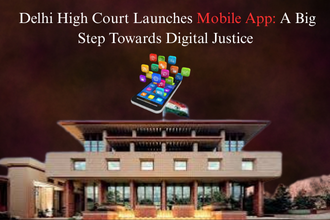The Delhi High Court has taken a major step forward in strengthening its digital infrastructure by launching its official mobile application on September 4, 2025. The app is now available for download on both Android and iOS devices, offering seamless access to all the e-services of the High Court.
This initiative marks a significant leap towards improving accessibility, transparency, and efficiency in the justice delivery system. With this app, judges, lawyers, litigants, and even the general public can now stay updated with case-related information at their fingertips.
Alongside the app, the Court also launched an e-HRMS Portal for judicial officers and introduced an e-office pilot project, furthering its commitment to digital governance.
Key Features of the Delhi High Court Mobile App
The newly launched app has been designed to cater to different stakeholders in the legal system—advocates, judges, litigants, and the public. Some of the most notable features include:
1. For Advocates
- Case Access: Lawyers can view cases they have filed as well as those where they have filed a vakalatnama.
- Case Tracking: Advocates can add cases, including those not filed by them, for tracking purposes.
- Cause Lists: The app allows generation of daily cause lists, helping advocates manage their schedules more efficiently.
- Case Monitoring: The “view or add cases” tab enables advocates to monitor ongoing matters, highlight important cases, and review past orders and case histories.
This makes it much easier for busy lawyers to manage their workload, especially those handling multiple courts.
2. For Judges
- Dynamic Dashboard: Judges have access to a dedicated dashboard showing:
- Pending matters
- Cases instituted and disposed of in the current month
- Matters reserved for judgment
- Data-Driven Insights: This dashboard helps judges prioritize cases, monitor case flow, and ensure timely judgments.
3. For Litigants and the General Public
- Case Information: Litigants can track their cases directly without having to depend on intermediaries.
- Transparency: The app promotes greater transparency by making judicial information accessible in real time.
E-HRMS Portal for Judicial Officers
Along with the mobile app, the Delhi High Court also launched the e-HRMS Portal (Electronic Human Resource Management System) for judicial officers.
This portal will:
- Digitize HR management processes for judges and judicial staff.
- Allow smooth communication between the High Court registry and judicial officers.
- Enhance efficiency by reducing paperwork and delays.
- Ensure secure and transparent exchanges of information.
The digitization of HR processes is a vital move in creating a more accountable and technology-driven judiciary.
E-Office Pilot Project
The Court also announced the launch of an e-office pilot project. This initiative is designed to:
- Minimize physical paperwork.
- Shift to paperless offices across court departments.
- Improve file tracking, storage, and record-keeping efficiency.
- Enhance productivity and streamline communication.
If successful, this project could pave the way for a fully paperless judiciary in Delhi, serving as a model for other High Courts in India.
Expansion of E-Courts Platform
In another notable development, the Appellate Tribunal and the Juvenile Justice Boards have been onboarded onto the e-courts platform.
This integration is a crucial step towards ensuring that every judicial body under the Delhi High Court operates within a unified digital ecosystem. It will enable:
- Easy sharing of information.
- Faster case processing.
- Better tracking of juvenile and appellate matters.
Dignitaries Present at the Launch
The event was attended by several prominent figures from the judiciary and government, including:
- Justice Vikram Nath (Supreme Court of India)
- Chief Justice Devendra Kumar Upadhyaya (Delhi High Court)
- Rekha Gupta (Chief Minister of Delhi)
- Justice Prathiba M Singh (Chairperson, Information Technology & Artificial Intelligence Committee and Accessibility Committee)
- Other sitting judges of the High Court
Their presence highlighted the significance of this digital initiative, underscoring the judiciary’s commitment to modernizing court services.
Importance of the Delhi High Court Mobile App
The launch of the mobile app is not just a technological advancement but also a judicial reform milestone. Here’s why it matters:
- Enhanced Accessibility:
- Lawyers and litigants can now access critical case-related information anywhere, anytime.
- Time Efficiency:
- Judges and advocates can save valuable time through dashboards, cause lists, and case monitoring tools.
- Transparency:
- Litigants and the public can directly view case progress, reducing dependency on intermediaries.
- Digital Transformation:
- The move aligns with the Digital India mission, pushing the justice system closer to a paperless, technology-driven model.
- Boost to E-Courts Project:
- With tribunals and juvenile boards onboarded, Delhi is moving closer to a completely digitized judiciary.
Challenges Ahead
While the initiative is commendable, certain challenges need to be addressed:
- Digital Literacy: Not all litigants and lawyers are comfortable with mobile technology. Training and awareness drives will be essential.
- Infrastructure Gaps: Internet connectivity issues in rural areas may affect accessibility.
- Data Security: Ensuring data privacy and preventing misuse of sensitive case information will be critical.
- Technical Support: Continuous updates, bug fixes, and customer support will be required to ensure smooth functioning.
Conclusion
The Delhi High Court Mobile App launch marks a transformative moment for the Indian judicial system. By integrating advanced digital tools, the High Court is setting an example for other courts across the country.
From case tracking and daily cause lists for advocates to dynamic dashboards for judges and transparency for litigants, the app has the potential to revolutionize how justice is delivered.
With additional initiatives like the e-HRMS portal, e-office pilot project, and e-courts expansion, the Delhi High Court is paving the way towards a digitally empowered judiciary that is swift, transparent, and efficient.
As India embraces the digital era, such steps bring us closer to the vision of “accessible justice for all”, where technology bridges the gap between courts and citizens.
Also Read
Punjab & Haryana High Court Declines Immediate Intervention in Punjab Floods PIL
Supreme Court Criticises Punjab & Haryana High Court Over Anticipatory Bail Plea in Corruption Case



